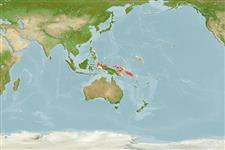>
Ovalentaria/misc (Various families in series Ovalentaria) >
Pomacentridae (Damselfishes) > Pomacentrinae
Etymology: Neoglyphidodon: Greek, para = the side of + Greek, glyphis = carved + Greek, odous = teeth; mitratus: Name from Latin, meaning 'wearing a head band', referring to the distinctive braon bars on the head.
Environment: milieu / climate zone / depth range / distribution range
Ecologia
marino associati a barriera corallina; distribuzione batimetrica 10 - 45 m (Ref. 90102). Tropical
Distribuzione
Stati | Aree FAO | Ecosystems | Presenze | Point map | Introduzioni | Faunafri
Western Pacific: Solomon Is. (New Georgia I.).
Size / Peso / Age
Maturity: Lm ? range ? - ? cm
Max length : 6.2 cm SL maschio/sesso non determinato; (Ref. 90102)
Short description
Chiavi di identificazione | Morfologia | Morfometria
Spine dorsali (totale) : 13; Raggi dorsali molli (totale) : 13; Spine anali: 2; Raggi anali molli: 13.
Inhabits sheltered outer reef often associated with branching coral in about 15-45 m (Ref. 90102). Close relative of N. thoracotaeniatus (Ref. 90102).
Life cycle and mating behavior
Maturità | Riproduzione | Deposizione | Uova | Fecundity | Larve
Allen, G.R. and M.V. Erdmann, 2012. Reef fishes of the East Indies. Perth, Australia: Universitiy of Hawai'i Press, Volumes I-III. Tropical Reef Research. (Ref. 90102)
IUCN Red List Status (Ref. 130435: Version 2024-1)
Threat to humans
Harmless
Human uses
Strumenti
Special reports
Download XML
Fonti Internet
Estimates based on models
Preferred temperature (Ref.
123201): 28 - 29.1, mean 28.8 °C (based on 16 cells).
Phylogenetic diversity index (Ref.
82804): PD
50 = 0.5020 [Uniqueness, from 0.5 = low to 2.0 = high].
Bayesian length-weight: a=0.02344 (0.01134 - 0.04848), b=2.98 (2.80 - 3.16), in cm total length, based on LWR estimates for this (Sub)family-body shape (Ref.
93245).
Trophic level (Ref.
69278): 2.8 ±0.3 se; based on size and trophs of closest relatives
Resilienza (Ref.
120179): Alto, tempo minimo di raddoppiamento della popolazione meno di 15 mesi (Preliminary K or Fecundity.).
Fishing Vulnerability (Ref.
59153): Low vulnerability (10 of 100).
